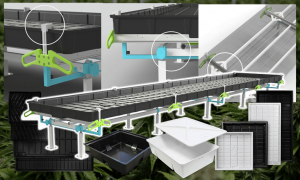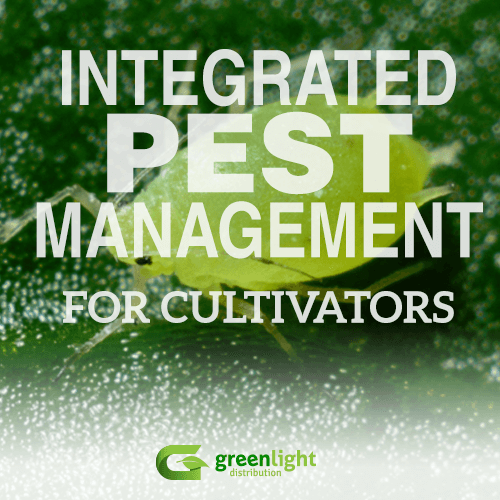Pests can have a significant impact on the yield and quality of cannabis crops, making it essential for cultivators to have a pest management plan in place. Integrated pest management (IPM) is a holistic approach that cultivators can use to control pests while minimizing the use of pesticides.
IPM involves combining different pest control strategies to create a comprehensive pest management plan. These strategies can include cultural, physical, and biological control methods, as well as the judicious use of pesticides. The goal of IPM is to create an environment that is hostile to pests, making it difficult for them to survive and reproduce.
Cultural Control Methods
Cultural control methods involve altering the growing environment to make it less hospitable to pests. This can include measures such as:
- Sanitation: Keeping the growing area clean and free of debris can help reduce the risk of pests.
- Plant selection: Choosing cannabis varieties that are resistant to pests can reduce the need for pesticide use.
- Crop rotation: Rotating crops can help prevent the buildup of pests in the soil.
- Physical Control Methods
- Physical control methods involve using physical barriers or traps to prevent pests from reaching the plants. This can include measures such as:
- Installing screens or nets: Screens or nets can prevent pests from entering the growing area.
- Using sticky traps: Sticky traps can be used to catch flying insects, such as fungus gnats.
Biological Control Methods
Biological control methods involve using natural predators or pathogens to control pests. This can include measures such as:
- Using predatory insects: Ladybugs and lacewings are examples of predatory insects that can be used to control pests.
- Using beneficial nematodes: Beneficial nematodes are microscopic worms that can be used to control soil-dwelling pests.
Pesticide Use
While pesticides can be an effective tool for controlling pests, they should be used judiciously in an IPM program. Pesticides should only be used when other control methods have failed, and only after careful consideration of their potential impact on the environment and human health. When using pesticides, cultivators should:
- Choose pesticides that are specifically labeled for use on cannabis.
- Follow all label instructions carefully.
- Wear protective gear when handling pesticides.
- Keep records of all pesticide use.
- Dispose of pesticide containers and unused product properly.
Integrated pest management is a holistic approach that cultivators can use to control pests while minimizing the use of pesticides. By combining cultural, physical, and biological control methods, cultivators can create an environment that is hostile to pests, reducing the risk of crop damage and ensuring a healthy and productive cannabis crop.
When using pesticides, cultivators should follow label instructions carefully and use them judiciously. With the right pest management plan in place, cultivators can produce high-quality cannabis crops while minimizing the impact on the environment and human health.
Contact us

Why Cannabis Industry Operators Partner with Greenlight Distribution
We’re excited to offer an incredible opportunity for new customers to save even more on top of our already discounted prices! Join the Greenlight Cultivator Club today and enjoy an additional 5% OFF your first order on essential commercial cannabis cultivation equipment.

Get 5% Off Your First Greenlight Order
We’re excited to offer an incredible opportunity for new customers to save even more on top of our already discounted prices! Join the Greenlight Cultivator Club today and enjoy an additional 5% OFF your first order on essential commercial cannabis cultivation equipment.

Improve your cannabis quality with Reverse Osmosis Water Treatment
Did you know that water quality can significantly impact your indoor flower’s quality and yield? If you’re using municipal water, groundwater, or well water, considering Reverse Osmosis (R.O.) is crucial for reaching A+++ flower quality.

Greenlight Distribution leads the way in maximizing cannabis yields and profits
Through our commitment to affordability, quality, expert support, and financial flexibility, Greenlight Distribution provides cultivators with the tools and knowledge you need to thrive.

Expand your cannabis cultivation operation with Greenlight
In the rapidly growing cannabis industry, licensed cannabis cultivators face challenges from regulatory compliance to scaling operations efficiently. With the right partners and resources, these challenges can be turned into opportunities for growth and success.

Cultivate growth with Greenlight’s financing solutions
As a premier direct lender to the cannabis industry, we specialize in providing tailored financing solutions to empower cultivators like you to thrive in a rapidly evolving market.

Maximize your growing space with a slide bench system
The Botanicare® Track Bench System is a game-changer for cannabis cultivators looking to elevate their operations to new heights.

Elevate Your Cannabis Cultivation with the new GAVITA RS 1900E LED grow light
The new GAVITA RS 1900E LED 208-480 V grow light from Greenlight Distribution emerges as a game-changer for cannabis cultivators.
